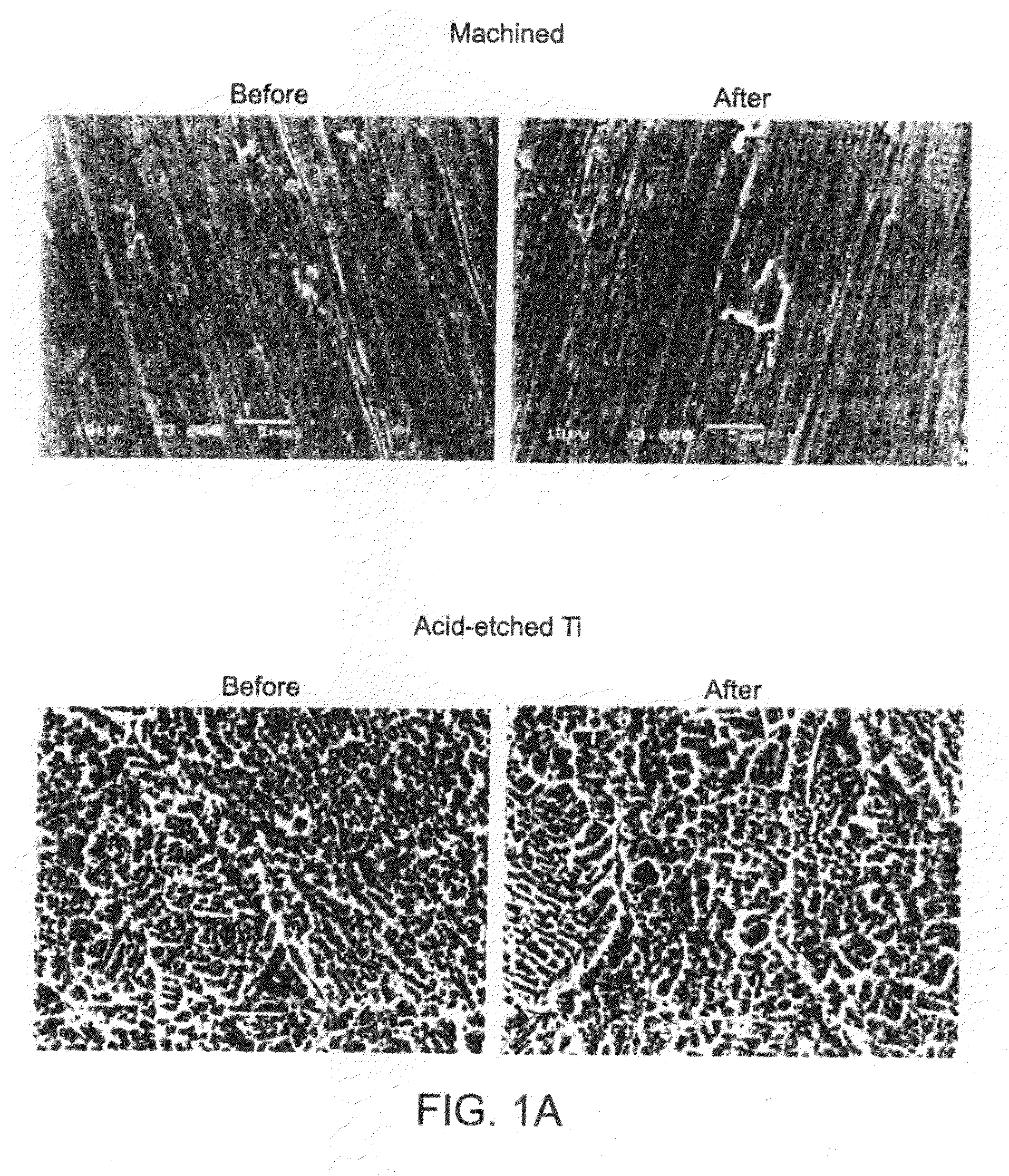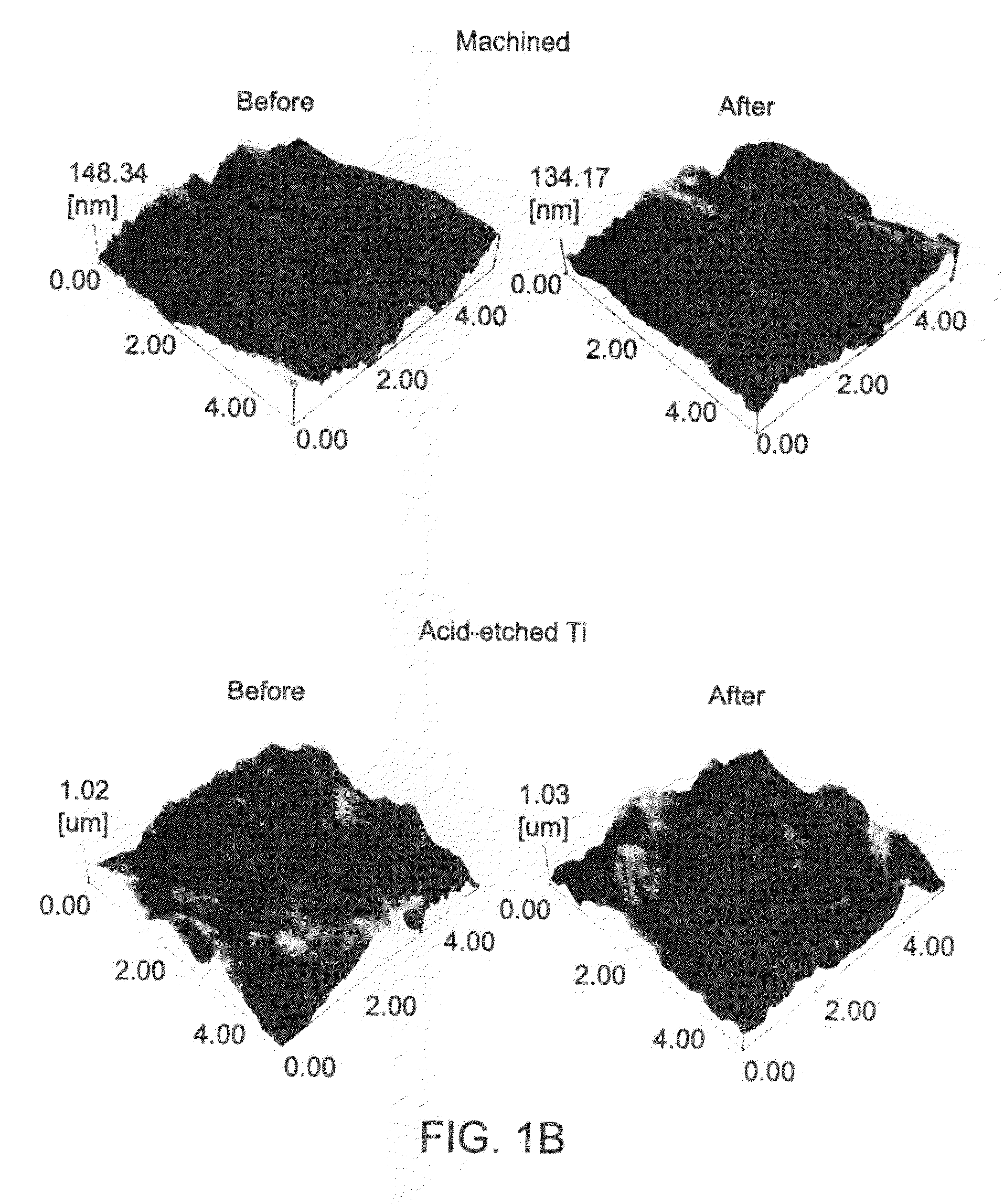Medical Implants
- Summary
- Abstract
- Description
- Claims
- Application Information
AI Technical Summary
Benefits of technology
Problems solved by technology
Method used
Image
Examples
example 1
Bone Generation by Light-Induced Super-Amphiphilic Titanium Implants
[0054]Methods
[0055]Titanium Samples, Surface Analysis and Ultraviolet UV Light Irradiation
[0056]Two surface types of commercially pure titanium were prepared for cylindrical implants (1 mm in diameter and 2 mm in length) and disks (20 mm in diameter and 1.5 mm in thickness). One had a machined surface, turned by a lathe. The other was dual acid-etched with H2SO4 and HCl (Osseotite®; Implant Innovations, West Palm Beach, Fla.). The titanium disks were sterilized by gamma radiation. Surface morphology was examined by scanning electron microscopy (SEM) (JSM-5900LV, Joel Ltd, Tokyo, Japan) and atomic force microscopy (SPM-9500J3, Shimadzu, Tokyo, Japan). The average roughness (Ra), root mean square roughness (Rrms) and peak-to-valley (Rp-v) were calculated. Titanium discs and implants were irradiated with UV at a level of 0.1 mW / cm2 UVA and 0.03 mW / cm2 UVB for 48 hours with air ventilation.
[0057]Wet Ability of Titanium ...
example 2
Light-Induced Super-Amphiphilic Titanium Accelerates and Enhances Bone-Implant Integration through Selective Cell- and Tissue-Philicity
[0087]Methods
[0088]Titanium Samples, Surface Analysis and Ultraviolet UV Light Irradiation. Two surface types of commercially pure titanium were prepared for cylindrical implants (1 mm in diameter and 2 mm in length) and disks (20 mm in diameter and 1.5 mm in thickness). One had a machined surface, turned by a lathe. The other was dual acid-etched with H2SO4 and HCl (Osseotite®; Implant Innovations, West Palm Beach, Fla.). The titanium disks were sterilized by gamma radiation. Surface morphology was examined by scanning electron microscopy (SEM) (JSM-5900LV, Joel Ltd, Tokyo, Japan) and atomic force microscopy (SPM-9500J3, Shimadzu, Tokyo, Japan). The average roughness (Ra), root mean square roughness (Rrms) and peak-to-valley (Rp-v) were calculated. Titanium discs and implants were irradiated with 0.1 mW / cm2 UVA and 0.03 mW / cm2 UVB for 48 hours with ...
example 3
Light-Induced Osteoblastophilic Surface Created on Freshly Prepared Sandblasted Titanium
[0120]Introduction
[0121]One of the challenges in the development of new titanium implants is how to overcome an inverted correlation between proliferation and differentiation rates of osteoblasts (Stein, G. S. & Lian, J. B. Endocr Rev 14, 424-42 (1993); Siddhanti, S. R. & Quarles, L. D., J Cell Biochem 55, 310-20 (1994); Alborzi, A., et al., J Craniofac Genet Dev Biol 16, 94-106 (1996)). For instance, increased rate differentiation concomitant with diminished proliferation of osteoblasts has been demonstrated in various roughed surfaces, which are common implant surfaces for dental implants (Takeuchi, K., et al., J Biomed Mater Res A 72A, 296-305 (2005); Bachle, M. & Kohal, R J., Clin Oral Implants Res 15, 683-92 (2004)). Examples 1 and 2 establish that the light-induced super-amphiphilic (hydrophilic and oleophilic) surfaces of titanium that overcomes the osteoblastic nature. The osteoblastic pr...
PUM
| Property | Measurement | Unit |
|---|---|---|
| Size | aaaaa | aaaaa |
| Size | aaaaa | aaaaa |
| Size | aaaaa | aaaaa |
Abstract
Description
Claims
Application Information
 Login to View More
Login to View More - R&D
- Intellectual Property
- Life Sciences
- Materials
- Tech Scout
- Unparalleled Data Quality
- Higher Quality Content
- 60% Fewer Hallucinations
Browse by: Latest US Patents, China's latest patents, Technical Efficacy Thesaurus, Application Domain, Technology Topic, Popular Technical Reports.
© 2025 PatSnap. All rights reserved.Legal|Privacy policy|Modern Slavery Act Transparency Statement|Sitemap|About US| Contact US: help@patsnap.com



